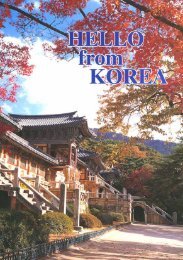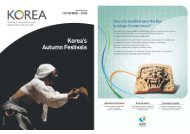www.korea.net
KOREAN MOVIES - Korea.net
KOREAN MOVIES - Korea.net
- No tags were found...
Create successful ePaper yourself
Turn your PDF publications into a flip-book with our unique Google optimized e-Paper software.
paste, right after they are caught. If the raw meal<br />
seems too bold, bingeo can also be prepared<br />
cooked and seasoned. You don’t have to look too<br />
far for restaurants — there is a line of snack bars<br />
shielded from the chilly winds by tents pitched<br />
around the festival venue on Soyangho lake.<br />
Though the 2010 Icefish Festival was held from<br />
January 28 to 31, die-hard bingeo afficionados<br />
start visiting the frozen rivers from mid-January<br />
to early February, when the river starts to freeze.<br />
Mount Seoraksan was the fifth mountain to be<br />
designated a national park in Korea. When people<br />
hear the name, they might think of its main<br />
gateway city, Sokcho, but the inland region of<br />
this mountain is actually located in Inje. Mount<br />
Seoraksan is divided into Naeseorak (Inner<br />
Seorak), Waeseorak (Outer Seorak), and<br />
Namseorak (South Seorak). Naeseorak is located<br />
in Inje, Waeseorak in Goseong and Sokcho, and<br />
Namseorak in Yangyang and Inje. The mountain<br />
peaks and ridges have become the natural borders<br />
dividing the regions, creating different traditions<br />
and lifestyles for each. There are 96 mountains<br />
in Inje and some 91 percent of its total<br />
area consists of peaks and rivers, creating the<br />
depth of its valleys.<br />
Though the fiery-hue of autumnal foliage is<br />
typically the first image to grace people’s minds<br />
when they hear Mount Seoraksan mentioned, the<br />
landscape is actually pure white and snowy for<br />
most of the year. The mountain’s snow cover<br />
remains for so long, in fact, that is said that<br />
snow from Chuseok (the Korean harvest holiday<br />
in September) doesn’t melt until Dano (the fifth<br />
day of the fifth lunar month, around mid-June of<br />
the solar calendar). This is how it earned its<br />
name, which in Korean means a snowy mountain<br />
that is difficult to climb.<br />
A SPIRITUAL WINTER On a recent winter’s day,<br />
heavy snowfall froze all roads and stopped all<br />
shuttle buses. Visitors to the area were told that<br />
they would have to walk 14km to reach<br />
Baekdamsa temple. The suddenly-limited traffic<br />
saw Baekdamsa return to its past, when it was<br />
once a secluded temple with few visitors. After<br />
walking along the solitary valley for two hours, it<br />
feels as if the world had widened and broadened.<br />
There are few people willing to take on the<br />
mountains, and the chirping of the birds<br />
becomes defined and clear. On the snow, the<br />
footprints of a rabbit skipping to look for spring<br />
water are imprinted like a winter shadow. Only<br />
after crossing two bridges and climbing three<br />
hills — causing sweat to caress my forehead —<br />
does the Iljumun gate appear. I cross the last<br />
bridge, the Susingyo, and finally I arrive at the<br />
Baekdamsa temple.<br />
One of the founding temples of the Jogye<br />
Order of Korean Buddhism, only 40 people a<br />
year undertake the challenge of pursuing the<br />
temple’s strict teaching — the first step to<br />
becoming a monk. To catch a glimpse into a<br />
monk’s life without the six months of training,<br />
visitors can easily participate in a temple stay.<br />
The short program offers lessons on meditation,<br />
the 108 bows, dado (tea ceremony),<br />
balwu-gongyang (eating practices) and yoga. For<br />
those who can’t stay long, relax for a warm cup of<br />
green tea and add a stone on the pagoda at the<br />
temple’s entrance, which symbolizes leaving<br />
behind one’s worries.<br />
My footsteps climbing down the mountain are<br />
lighter, the weather warmer. It’s a delight to see<br />
the animals, invisible from a car’s vantage point,<br />
while walking the silent wintry road. Winter in<br />
Inje — this is spiritual training.<br />
HOW TO GO<br />
> By Bus Take a bus at Dong (East)<br />
Seoul Bus Terminal ([02] 446-8000) or<br />
Sangbong Bus Terminal ([02] 323-<br />
5885). The ride takes around two<br />
hours and 20 minutes to Inje.<br />
> By Car Take Gyeongchun<br />
Expressway from Seoul through Donghongcheon<br />
to Inje (an hour and 30<br />
minutes), or Youngdong Expressway<br />
through Wonju and Hongcheon to Inje<br />
(two hours and 30 minutes). You must<br />
take National Road No 44 from<br />
Hongcheon. For more information, call<br />
the Inje Tourism Information Center on<br />
1588-6226, [033] 460-2170 or visit<br />
<strong>www</strong>.inje.go.kr.<br />
HWANGTAE FESTIVAL, YONGDAE-RI<br />
> Date Feb. 26-Mar. 1, 2010<br />
> Address Yongdae 3-ri, Inje.<br />
For more information, call [033] 462-<br />
4808 or visit <strong>www</strong>.yongdaeri.com.<br />
BAEKDAMSA TEMPLE<br />
> Address 690 Yongdae-ri, Bukmyeon,<br />
Inje. For more information, call<br />
[033] 462-6969, Temple Secretariat<br />
[033] 462-5565 or <strong>www</strong>.baekdamsa.org.<br />
> Temple Stay Fee Rest for one day<br />
(30,000 Korean won [US$27.27]), two<br />
days & one night (70,000 won<br />
[US$63.63]), three days & two nights<br />
(100,000 won [US$90.90]), etc.<br />
The water of Soyanggang river lies frozen (above). The bell of<br />
Baekdamsa temple (opposite top). A woman is enjoying ice fishing<br />
on bingjang, ice plaza in Inje (opposite bottom).<br />
KOREA<br />
FEBRUARY<br />
2010<br />
31
















